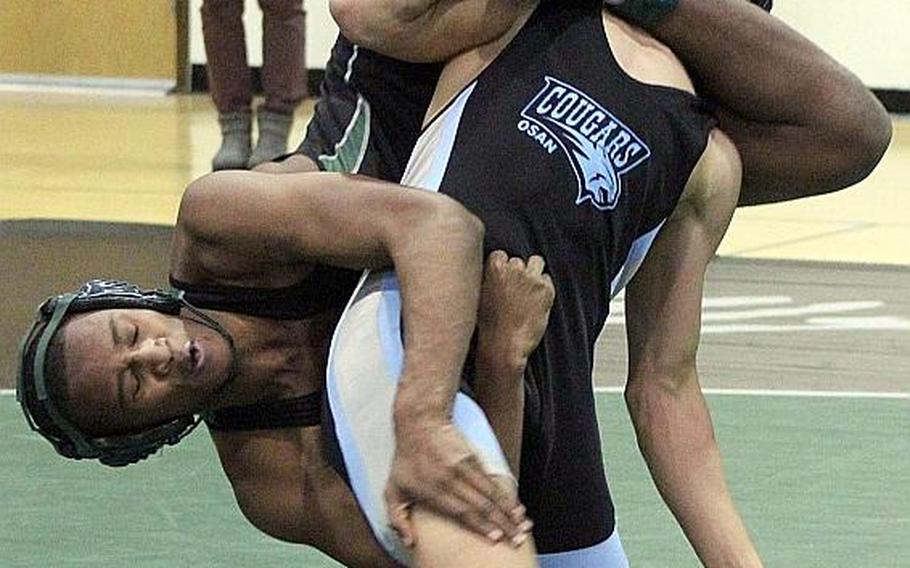
Osan's Marcus Inthavixay lifts Daegu's Gavin Jackson in the 158-pound bout during a DODEA-Korea wrestling quad meet at Camp Walke rin January. Inthavixay won a 12-9 decision and has gone unbeaten against Jackson this season. (Mary Sarantakes/Special to Stripes)
With four teams and 13 weight classes, a typical DODEA-Korea high school wrestling quad meet could – in theory - feature 78 bouts.
This season, the average number of bouts had been 20.7 entering Saturday’s meet at Humphreys. But the first meet at the school in two years featured just three teams and a season-low 11 bouts.
“I felt bad for my kids and their parents,” coach Ben Pak of Humphreys said. “I had people coming. I emailed the staff. The kids were telling their teachers and their parents. They came out to see them wrestle, but no matches.”
The number of wrestlers in Korea has been historically low, particularly at Daegu, Osan and Seoul American, whose enrollment has nosedived – now down to 157 – before its scheduled closure in June.
Only three wrestlers from Daegu, with an enrollment of 141, and five from Seoul American attended the tri-meet, in which Humphreys filled 12 of 13 weight classes. Humphreys is the largest school in Korea, with an enrollment of 531 expected to spike above 700 next year, Pak said.
Osan, with an enrollment of 164, only had one available wrestler, coach Andrew Grant said, adding that was “not enough wrestlers to warrant the trip.” Grant said the Cougars are planning to attend the season-ending quad meet next Saturday, also at Humphreys.
The 11 bouts contested between teams took about 45 minutes, Pak said. The rest of the time, “we had exhibitions among teammates, which was no fun because we do that all the time during practice,” he said.
Fuente Pedro, a senior transfer from Fort Bliss, Texas, has had no bouts at 115 pounds other than against teammates and he probably won’t prior to Far East at Nile C. Kinnick on Feb. 21-23.
“That’s a big handicap,” Pedro said. “Without wrestling other teams, I don’t know what other wrestlers have. It makes it very difficult.”
Such problems appear to be minimal at schools in Japan and Okinawa.
The larger schools such as Kadena (830 students) and Kubasaki (573) on Okinawa and Nile C. Kinnick (617), Zama (282) and Yokota (321) have full or almost-full lineups and serious competition against Tokyo-area international schools.
Even Japan’s smaller schools, Robert D. Edgren (172) and Matthew C. Perry (227) have full or almost-full lineups. Edgren took first place in a dual-meet tournament at Zama on Feb. 2. Only E.J. King, with 157 students, was unable to field a team this season.
“Pacific East (DODEA-Japan) and Pacific South (Okinawa) have the numbers, but if you look at the travel rosters (for Far East), Daegu and Osan are in trouble,” DODEA-Pacific athletics coordinator Tom McKinney said.
Several other factors combine to create the low numbers in Korea.
--Two-time Far East champion Kojiro VanHoose of Osan says many are embarrassed to appear on the mat wearing singlets that don’t do much to hide a wrestler’s privates.
“Wrestlers would rather wear the two-piece uniforms” that appear to be gaining popularity in the States, VanHoose said.
--There’s a lack of in-season competition with anybody else. The league’s schedule includes two Saturdays in December at Korean physical education schools in Daegu and Daejeon.
But those are against locals who “live, breathe, eat and sleep” the sport, Pak said. “Their level is too high and they are not allowed to go 100 percent or do throws against the DODEA schools.”
The one major in-season invitational is the “Beast of the Far East” tournament at Kinnick, but that is self-funded travel.
“I need Kubasaki and Kadena,” Pak said. “We need to travel. We need to do a three-way with them.”
McKinney said travel options for Korea are on the table.
“There are always ways to look at how we get that extra trip” for Korea teams, he said.
--Perhaps the most serious issue is a lack of coaching continuity.
“We just don’t have coaches that stay around to build a program,” Pak said.
Grant is new to Osan’s problem and Brittney Waldner, Seoul’s athletics director, assumed the Falcons’ helm from Pak when he transferred to Humphreys. Jeramie Lentz has coached Daegu for six total seasons, but took the 2015-16 and 2016-17 seasons off.
Korea’s teams, Pak said, haven’t had the likes of a Julian Harden, who coached Seoul American for 17 seasons and to three Far East team titles until he stepped down in 2009.
Pak fears the situation will only get worse next year, when Seoul American closes.
“If the other two schools only have two or three wrestlers each, we might as well shut the program down,” Pak said. “A coach needs to take the initiative instead of waiting for people to come to them; if not, it’s just two or three students.”
Grant, for one, says he’s in it for the long haul.
“I’m hoping to triple the numbers next year,” he said. “I would hate to see the program go away, that’s for sure.”